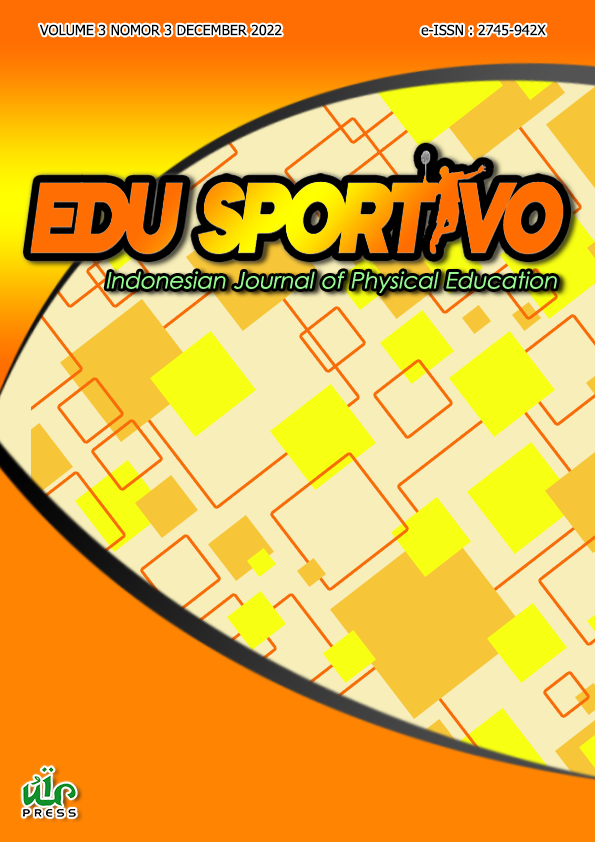A sudden shift: Students' perception of distance and online education in physical education amidst COVID-19 Pandemic
Keywords:
Perception, distance education, online learning, physical educationAbstract
Students' perception is critical because it provides essential information about the current benefits and challenges they are experiencing in the distance and online education setting. This study explores students' perception of physical education regarding the current educational environment in respect to gender, family accommodation, income, gadget, and source of internet connection. 262 1st year students taking minor PE are the participants in this study. Descriptive statistics such as frequency and percentage were utilized to describe the demographic characteristics of the respondents. At the same time, mean and standard deviation were used to describe students' attitudes towards distance and online education. Also, One-way ANOVA, Mann-Whitney U, and Kruskal Wallis H were utilized to determine the significant difference between groups regarding their perspective in the current educational setting. Based on the results, a statistically significant difference was found between groups concerning family accommodation. On the other hand, no difference was observed between groups of gender, income, gadget, and source of internet connection. In summary, most of the students positively perceived this current setting as beneficial to them. However, there are still challenges that pose threats to this current system. In this regard, the recommendation to address the challenges observed based on study findings and recommendations for future research is a result of this.
Downloads
References
Abu-Talib, M., Bettayeb, A. M., & Omer, R. I. (2021). Analytical study on the impact of technology in higher education during the age of COVID-19: Systematic literature review. Education and Information Technologies, 26(6), 6719–6746. https://doi.org/10.1007/s10639-021-10507-1 DOI: https://doi.org/10.1007/s10639-021-10507-1
Abuhassna, H., & Yahaya, N. (2018). Students’ utilization of distance learning through an interventional online module based on moore transactional distance theory. Eurasia Journal of Mathematics, Science and Technology Education, 14(7), 3043–3052. https://doi.org/10.29333/ejmste/91606 DOI: https://doi.org/10.29333/ejmste/91606
Adnan, M. (2020). Online learning amid the COVID-19 pandemic: Students perspectives. Journal of Pedagogical Sociology and Psychology, 1(2), 45–51. https://doi.org/10.33902/jpsp.2020261309 DOI: https://doi.org/10.33902/JPSP.2020261309
Al-Rasheed, A. (2021). The Challenges Faced by Undergraduate Women during the COVID-19 Pandemic in Saudi Arabia. Education Research International, 2021, 1–10. https://doi.org/10.1155/2021/8841997 DOI: https://doi.org/10.1155/2021/8841997
Al-Rawashdeh, A. Z., Mohammed, E. Y., Al Arab, A. R., Alara, M., Al-Rawashdeh, B., & Al-Rawashdeh, B. (2021). Advantages and Disadvantages of Using e-Learning in University Education: Analyzing Students’ Perspectives. Electronic Journal of E-Learning, 19(3), 107–117. https://doi.org/10.34190/ejel.19.3.2168 DOI: https://doi.org/10.34190/ejel.19.3.2168
Almahasees, Z., Mohsen, K., & Amin, M. O. (2021). Faculty’s and Students’ Perceptions of Online Learning During COVID-19. Frontiers in Education, 6(May), 1–10. https://doi.org/10.3389/feduc.2021.638470 DOI: https://doi.org/10.3389/feduc.2021.638470
Alshahrani, S., Ahmed, E., & Ward, R. (2017). The influence of online resources on student–lecturer relationship in higher education: a comparison study. Journal of Computers in Education, 4(2), 87–106. https://doi.org/10.1007/s40692-017-0083-8 DOI: https://doi.org/10.1007/s40692-017-0083-8
Apriyanto, R., & Saputra, A. (2021). Effectiveness Of Online Learning and Physical Activities Study In Physical Education During Pandemic Covid 19. Kinestetik : Jurnal Ilmiah Pendidikan Jasmani, 5(1), 64–70. https://doi.org/10.33369/jk.v5i1.14264 DOI: https://doi.org/10.33369/jk.v5i1.14264
Bădău, A., & Bădău, D. (2020). The difficulties perceived by students from the specialization of physical education and sports in the online educational process. Health, Sports & Rehabilitation Medicine, 21(4), 217–222. https://doi.org/10.26659/pm3.2020.21.4.217 DOI: https://doi.org/10.26659/pm3.2020.21.4.217
Barrot, J. S., Llenares, I. I., & del Rosario, L. S. (2021). Students’ online learning challenges during the pandemic and how they cope with them: The case of the Philippines. Education and Information Technologies, 26(6), 7321–7338. https://doi.org/10.1007/s10639-021-10589-x DOI: https://doi.org/10.1007/s10639-021-10589-x
Cárcamo, B., & Pérez, C. (2022). Toward Autonomous Learning: Exploring the Impact of Participating in an Online Second Language Learning Course. International Journal of Information and Education Technology, 12(5), 449–455. https://doi.org/10.18178/ijiet.2022.12.5.1640 DOI: https://doi.org/10.18178/ijiet.2022.12.5.1640
Chan, W. K., Leung, K. I., Hoc, C., Wuc, W., Lam, K. Y., Wong, N. L., Chan, C. Y. R., Leung, K. M., & Tse, A. C. Y. (2021). Effectiveness of online teaching in physical education during covid-19 school closures: A survey study of frontline physical education teachers in Hong Kong. Journal of Physical Education and Sport, 21(4), 1622–1628. https://doi.org/10.7752/jpes.2021.04205 DOI: https://doi.org/10.7752/jpes.2021.04205
Coman, C., Țîru, L. G., Meseșan-Schmitz, L., Stanciu, C., & Bularca, M. C. (2020). Online Teaching and Learning in Higher Education during the Coronavirus Pandemic: Students’ Perspective. Sustainability, 12(24), 10367. https://doi.org/10.3390/su122410367 DOI: https://doi.org/10.3390/su122410367
Cullinan, J., Flannery, D., Harold, J., Lyons, S., & Palcic, D. (2021). The disconnected: COVID-19 and disparities in access to quality broadband for higher education students. International Journal of Educational Technology in Higher Education, 18(1), 26. https://doi.org/10.1186/s41239-021-00262-1 DOI: https://doi.org/10.1186/s41239-021-00262-1
D’Agostino, E. M., Urtel, M., Webster, C. A., McMullen, J., & Culp, B. (2021). Virtual Physical Education During COVID-19: Exploring Future Directions for Equitable Online Learning Tools. Frontiers in Sports and Active Living, 3(August), 1–6. https://doi.org/10.3389/fspor.2021.716566 DOI: https://doi.org/10.3389/fspor.2021.716566
Das, N. K., Sahoo, S., & Pati, L. (2021). Online Learning: Challenges for Education in Rural and Remote Areas. IARJSET, 8(7), 72–76. https://doi.org/10.17148/IARJSET.2021.8712 DOI: https://doi.org/10.17148/IARJSET.2021.8712
Delas-Penas, E. (2020). Challenges of Online Learning vs Traditional Learning for Students.
Dhawan, S. (2020). Online Learning: A Panacea in the Time of COVID-19 Crisis. Journal of Educational Technology Systems, 49(1), 5–22. https://doi.org/10.1177/0047239520934018 DOI: https://doi.org/10.1177/0047239520934018
Elshareif, E., & Mohamed, E. A. (2021). The Effects of E-Learning on Students’ Motivation to Learn in Higher Education. Online Learning, 25(3), 128–143. https://doi.org/10.24059/olj.v25i3.2336 DOI: https://doi.org/10.24059/olj.v25i3.2336
Fidalgo, P., Thormann, J., Kulyk, O., & Lencastre, J. A. (2020). Students’ perceptions on distance education: A multinational study. International Journal of Educational Technology in Higher Education, 17(1), 18. https://doi.org/10.1186/s41239-020-00194-2 DOI: https://doi.org/10.1186/s41239-020-00194-2
Foo, C. chung, Cheung, B., & Chu, K. man. (2021). A comparative study regarding distance learning and the conventional face-to-face approach conducted problem-based learning tutorial during the COVID-19 pandemic. BMC Medical Education, 21(1), 1–6. https://doi.org/10.1186/s12909-021-02575-1 DOI: https://doi.org/10.1186/s12909-021-02575-1
Gabriel, J., & Rhonda, D. (2020). Students transition from face to face learning to online learning at higher education: A case study in Trinidad and Tobago. Educational Research and Reviews, 15(8), 487–494. https://doi.org/10.5897/err2020.4005 DOI: https://doi.org/10.5897/ERR2020.4005
Guo, Y., Liao, M., Cai, W., Yu, X., Li, S., Ke, X., Tan, S., Luo, Z., Cui, Y., Wang, Q., Gao, X., Liu, J., Liu, Y., Zhu, S., & Zeng, F. (2021). Physical activity, screen exposure and sleep among students during the pandemic of COVID-19. Scientific Reports, 11(1), 8529. https://doi.org/10.1038/s41598-021-88071-4 DOI: https://doi.org/10.1038/s41598-021-88071-4
Gustiani, S. (2020). Students ’ Motivation in Online Learning During Covid-19 Pandemic Era : a Case Study. Holistics Journal, 12(2), 23–40.
Idris, F., Zulkipli, I. N., Abdul-Mumin, K. H., Ahmad, S. R., Mitha, S., Rahman, H. A., Rajabalaya, R., David, S. R., & Naing, L. (2021). Academic experiences, physical and mental health impact of COVID-19 pandemic on students and lecturers in health care education. BMC Medical Education, 21(1), 542. https://doi.org/10.1186/s12909-021-02968-2 DOI: https://doi.org/10.1186/s12909-021-02968-2
Jeong, H.-C., & So, W.-Y. (2020). Difficulties of Online Physical Education Classes in Middle and High School and an Efficient Operation Plan to Address Them. International Journal of Environmental Research and Public Health, 17(19), 7279. https://doi.org/10.3390/ijerph17197279 DOI: https://doi.org/10.3390/ijerph17197279
Jordan, R. C., Hamouda, S., Vaughan, J. L., Roddy, C., Amiet, D. L., Chung, J., Holt, C., Shaw, L., Mckenzie, S., Garivaldis, F., Lodge, J. M., & Mundy, M. E. (2017). Applying Best Practice Online Learning, Teaching, and Support to intensive Online environments: An integrative Review. 2. https://doi.org/10.3389/feduc.2017.00059 DOI: https://doi.org/10.3389/feduc.2017.00059
Khan, M. A., Vivek, Nabi, M. K., Khojah, M., & Tahir, M. (2021). Students’ perception towards e-learning during covid-19 pandemic in India: An empirical study. Sustainability (Switzerland), 13(1), 1–14. https://doi.org/10.3390/su13010057 DOI: https://doi.org/10.3390/su13010057
Kokoç, M. (2019). Flexibility in e-Learning: Modelling Its Relation to Behavioural Engagement and Academic Performance. Themes in ELearning, 12(12), 1–16.
Korlat, S., Kollmayer, M., Holzer, J., Lüftenegger, M., Pelikan, E. R., Schober, B., & Spiel, C. (2021). Gender Differences in Digital Learning During COVID-19: Competence Beliefs, Intrinsic Value, Learning Engagement, and Perceived Teacher Support. Frontiers in Psychology, 12(March 2020), 1–12. https://doi.org/10.3389/fpsyg.2021.637776 DOI: https://doi.org/10.3389/fpsyg.2021.637776
Kulal, A., & Nayak, A. (2020). A study on perception of teachers and students toward online classes in Dakshina Kannada and Udupi District. Asian Association of Open Universities Journal, 15(3), 285–296. https://doi.org/10.1108/AAOUJ-07-2020-0047 DOI: https://doi.org/10.1108/AAOUJ-07-2020-0047
Laguador, J. M. (2021). Challenges Encountered during Pandemic in Flexible Learning Among College Students Living in Urban, Rural, and Suburban Areas in the Philippines. Asia Pacific Journal of Educational Perspectives, 8(1), 10–18.
Lamanauskas, V., & Makarskaitė-Petkevičienė, R. (2021). Distance Lectures in University Studies: Advantages, Disadvantages, Improvement. Contemporary Educational Technology, 13(3), ep309. https://doi.org/10.30935/cedtech/10887 DOI: https://doi.org/10.30935/cedtech/10887
Lee, K.-J., Noh, B., & An, K.-O. (2021). Impact of Synchronous Online Physical Education Classes Using Tabata Training on Adolescents during COVID-19: A Randomized Controlled Study. International Journal of Environmental Research and Public Health, 18(19), 10305. https://doi.org/10.3390/ijerph181910305 DOI: https://doi.org/10.3390/ijerph181910305
Lembani, R., Gunter, A., Breines, M., & Dalu, M. T. B. (2020). The same course, different access: the digital divide between urban and rural distance education students in South Africa. Journal of Geography in Higher Education, 44(1), 70–84. https://doi.org/10.1080/03098265.2019.1694876 DOI: https://doi.org/10.1080/03098265.2019.1694876
Liu, X., He, W., Zhao, L., & Hong, J.-C. (2021). Gender Differences in Self-Regulated Online Learning During the COVID-19 Lockdown. Frontiers in Psychology, 12. https://doi.org/10.3389/fpsyg.2021.752131 DOI: https://doi.org/10.3389/fpsyg.2021.752131
Lobo, J., Dimalanta, G., Bautista, C., Buan, E., & De Dios, D. Al. (2022). TikTok Consumption and Level of Class Engagement of Performing Arts Students in the New Normal: Destructive or Beneficial? American Journal of Education and Technology, 1(1), 1–9. https://doi.org/10.54536/ajet.v1i1.305 DOI: https://doi.org/10.54536/ajet.v1i1.305
Martin, M., Laciste, G., & Concepcion, K. (2019). Prevalence of Modern Teaching Method among Senior High School Students. EDUCATUM Journal of Science, Mathematics and Technology, 6(1), 1–7. https://doi.org/10.37134/ejsmt.vol6.1.1.2019 DOI: https://doi.org/10.37134/ejsmt.vol6.1.1.2019
Masalimova, A. R., Khvatova, M. A., Chikileva, L. S., Zvyagintseva, E. P., Stepanova, V. V., & Melnik, M. V. (2022). Distance Learning in Higher Education During Covid-19. Frontiers in Education, 7. https://doi.org/10.3389/feduc.2022.822958 DOI: https://doi.org/10.3389/feduc.2022.822958
Meşe, E., & Çiğdem, S. (2021). Factors influencing EFL students’ motivation in online learning: A qualitative case study. Journal of Educational Technology & Online Learning, 4(1), 11–22.
Miller, K. (2019, September 25). The Benefits of Online Learning: 7 Advantages of Online Degrees. https://www.northeastern.edu/graduate/blog/benefits-of-online-learning/
Moate, K. M., Chukwuere, J. E., & Mavhungu, M. B. (2017). The impact of wireless fidelity on students’ academic performance in a developing economy. Proceedings of the 31st International Academic Conference, London, June. https://doi.org/10.20472/IAC.2017.031.032 DOI: https://doi.org/10.20472/IAC.2017.031.032
Monte, R. N., & Buan, A. R. (2021). The Impact of Covid-19 on Physical Education: Mobility-Restrictive Measures on the Remote Learning Setup. International Journal of Asian Social Science, 11(10), 474–489. https://doi.org/10.18488/journal.1.2021.1110.474.489 DOI: https://doi.org/10.18488/journal.1.2021.1110.474.489
Mpungose, C. B. (2020). Emergent transition from face-to-face to online learning in a South African University in the context of the Coronavirus pandemic. Humanities and Social Sciences Communications, 7(1), 1–9. https://doi.org/10.1057/s41599-020-00603-x DOI: https://doi.org/10.1057/s41599-020-00603-x
Mukhtar, K., Javed, K., Arooj, M., & Sethi, A. (2020). Advantages, Limitations and Recommendations for online learning during COVID-19 pandemic era. Pakistan Journal of Medical Sciences, 36(COVID19-S4), S27–S31. https://doi.org/10.12669/pjms.36.COVID19-S4.2785 DOI: https://doi.org/10.12669/pjms.36.COVID19-S4.2785
Muthuprasad, T., Aiswarya, S., Aditya, K. S., & Jha, G. K. (2021). Students’ perception and preference for online education in India during COVID -19 pandemic. Social Sciences & Humanities Open, 3(1), 100101. https://doi.org/10.1016/j.ssaho.2020.100101 DOI: https://doi.org/10.1016/j.ssaho.2020.100101
Omar, M., Ahmad, M., Yasin, A., Ibrahim, H., Ghazali, O., & Khamis, S. (2018). WiFi usage and student performance: Examining the interrelations for UUM students. AIP Conference Proceedings, 2016(September), 020115. https://doi.org/10.1063/1.5055517 DOI: https://doi.org/10.1063/1.5055517
Papanis, E., Giavrimis, P., & Papani, E.-M. (2010). The contribution of the Internet into learning. Review of European Studies, 2(1), 54–60. https://doi.org/10.5539/res.v2n1p54 DOI: https://doi.org/10.5539/res.v2n1p54
Peytcheva-Forsyth, R., Yovkova, B., & Aleksieva, L. (2018). Factors affecting students’ attitudes towards online learning - The case of Sofia University. AIP Conference Proceedings, 2048(December), 020025. https://doi.org/10.1063/1.5082043 DOI: https://doi.org/10.1063/1.5082043
Rachmat, N. (2020). Analysis Of Effectiveness Of Online Learning Pandemic Covid-19 In Prosthetic Orthotic Major In Polkesta. Interest : Jurnal Ilmu Kesehatan, 9(2), 123–133. https://doi.org/10.37341/interest.v9i2.198 DOI: https://doi.org/10.37341/interest.v9i2.198
Resdasari-Prasetyo, A., Nurtjahjanti, H., & Ardhiani, L. N. (2021). Impact of Changes in Teaching Methods During the COVID-19 Pandemic: The Effect of Integrative E-Learning on Readiness for Change and Interest in Learning Among Indonesian University Students. International Review of Research in Open and Distance Learning, 22(2), 87–101. https://doi.org/10.19173/irrodl.v22i2.5143 DOI: https://doi.org/10.19173/irrodl.v22i2.5143
Ridwan, M., Saputri, A. D. V., Pratiwi, I., & Cahyaningtias, V. P. (2022). Student Perceptions Related to Physical Education Online Learning During Covid-19 Pandemic. Proceedings of the International Joint Conference on Arts and Humanities 2021 (IJCAH 2021), 618(Ijcah), 421–426. https://doi.org/10.2991/assehr.k.211223.073 DOI: https://doi.org/10.2991/assehr.k.211223.073
Sandybayev, A. (2020). The Impact of E-Learning Technologies on Student’s Motivation: Student Centered Interaction in Business Education. International Journal of Research in Tourism and Hospitality, 6(2), 16–24. https://doi.org/10.20431/2455-0043.0601002 DOI: https://doi.org/10.20431/2455-0043.0601002
Siddiqui, M. I., Shah, R., & Ariser, K. N. (2021). Challenges of online learning and attitude of medical student at LUMHS: Comparative study among rural and urban students during covid -19 pandemic. Medical Forum Monthly, 32(5), 82–86.
Simamora, R. M. (2020). The Challenges of Online Learning during the COVID-19 Pandemic: An Essay Analysis of Performing Arts Education Students. Studies in Learning and Teaching, 1(2), 86–103. https://doi.org/10.46627/silet.v1i2.38 DOI: https://doi.org/10.46627/silet.v1i2.38
Tegero, M. C. (2021) Teaching in Times of COVID-19 Pandemic. International Journal of Research Publications, 91(1), 1–5. https://doi.org/10.47119/IJRP1009111220212595 DOI: https://doi.org/10.47119/IJRP1009111220212595
Todri, A., Papajorgji, P., Moskowitz, H., & Scalera, F. (2021). Perceptions regarding distance learning in higher education, smoothing the transition. Contemporary Educational Technology, 13(1), 1–13. https://doi.org/10.30935/cedtech/9274 DOI: https://doi.org/10.30935/cedtech/9274
Turan, Z., Kucuk, S., & Karabey, S. C. (2022). The university students ’ self ‑ regulated effort , flexibility and satisfaction in distance education. International Journal of Educational Technology in Higher Education. https://doi.org/10.1186/s41239-022-00342-w DOI: https://doi.org/10.1186/s41239-022-00342-w
Yu, Z. (2021). The effects of gender, educational level, and personality on online learning outcomes during the COVID-19 pandemic. International Journal of Educational Technology in Higher Education, 18(1). https://doi.org/10.1186/s41239-021-00252-3 DOI: https://doi.org/10.1186/s41239-021-00252-3
Published
How to Cite
Issue
Section
This is an open-access article distributed under the terms of the Creative Commons Attribution-ShareAlike 4.0 International License which permits unrestricted use, distribution, and reproduction in any medium. Users are allowed to read, download, copy, distribute, search, or link to full-text articles in this journal without asking by giving appropriate credit, provide a link to the license, and indicate if changes were made. All of the remix, transform, or build upon the material must distribute the contributions under the same license as the original.
Accepted 2022-08-30
Published 2022-09-12



.png)




















.png)







.png)





